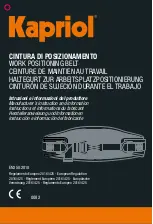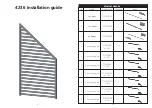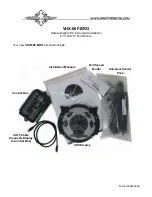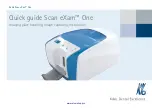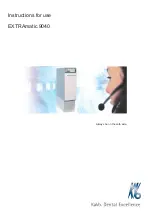
13.15 Wheel Replacement
If it is necessary to remove a wheel, place a jack
underneath the axle beam, loosen the wheel nuts and
raise the machine. Place an axle stand underneath the
machine, remove wheel nuts completely and remove the
wheel. Refit the wheel and tighten the wheel nuts to the
torque in 13.16.
13.16 Wheel Nuts
Before using a new machine and daily during use, check
the wheel nuts are tight. The recommended torque for
the 6 stud wheel is 400Nm (320lb.ft).
Once the nuts are allowed to work loose, it may be
impossible to keep them tight and new nuts and studs will
be required. In extreme cases, damage to the wheel rims
and hubs may result.
13.17 Tyre Pressures
Check tyre pressures regularly, inflate to the pressures
shown in the following table. Incorrect inflation can be
dangerous.
Table 6. Tyre pressures.
13.18 Handbrake Adjustment
With reference to Figure 14, the handbrake can be
adjusted by releasing the lock nut (item 1) and increasing
tension by means of the tension nut (item 2). If maximum
travel is reached then the clamp (item 3) can be released
and the cable adjusted accordingly.
Figure 14. Handbrake adjustment
13.19 Service Brake Adjustment
It is imperative that the brakes are adjusted correctly to
meet the requirements of the braking regulations. As the
brake shoes wear, it may be necessary to realign the
actuating rods on their splines so that the arms are
perpendicular to the ram body.
13.20 Lubrication
Good quality semi-solid grease should be applied to the
grease points as shown on the relevant lubrication chart
on pages 2 to 5.
The frequencies stated are based on typical daily use for
bedding & feeding purposes. Continuous use for special
applications will necessitate more frequent lubrication.
13.21 Maintenance Schedule
The above frequencies are based on typical daily use for
bedding & feeding purposes. Continuous use for special
applications will necessitate more frequent lubrication.
Table 7. Maintenance schedule
14 OPTIONAL EXTRAS
14.1 Drawbar And Axle Kit (7100 / 7150 models)
The drawbar is attached to the front of the machine by 4
bolts, there are 2 positions available allowing the ring
hitch height to be matched to the height of the pick up
hitch on the tractor. Where a clevis hitch is fitted the
height of the clevis can also be adjusted by altering it’s
position relative to the drawbar.
The axle is attached by 4 bolts to the main chassis
members of the body.
When attaching the machine check that the lower links
are at a height such that they do not contact the PTO
shaft when the tractor is turning. If they are not used
regularly, it is recommended that they be removed.
Fit the combined slip and overrun clutch unit end of the
PTO shaft to the machine.
Gradually turn the tractor until maximum turning lock is
achieved, and drive over undulating ground, checking that
the PTO shaft does not come to within 100 mm (4 inches)
of bottoming. If necessary, cut the PTO shaft to the
correct length. With the shaft in its most extended
position, there should not be less than half of the original
22
Greasing / Oil
See separate chart on pages 2
to 5
PTO and clutch
Lubricate as chart
Dismantle clutch at start of
season and monthly during use.
Gearboxes
Replace main gearbox oil after
first 50 hours then check
monthly. Where fitted, check
bed chain drive gearbox
monthly.
Remove stones
Each bale or daily,
depending on use and
nature of bales
Bed chain
tension
After first day then
weekly depending on use
Crossbeater chain
tension
Weekly
Clean above
inspection panel
Monthly, depending on use
Tyre pressures &
wheel nuts
Monthly
Option – replace
oil filter
Annually
Tyre Size
Tomahawk 7100, 7150, 8100,
8150, 8500 & 8550
Pressure bar (psi)
10.0/75-15.3
2.0 ( 29 )
11.5/80-15.3
1.2 ( 17 )
12.5/80-15.3
1.2 ( 17 )
7.50 - 16.0 (14PR)
5.8 ( 84 )
Tyre Size
Tomahawk 9500 & 1010
Pressure bar (psi)
305/55 R22.5
7 (100)
385/55 R22.5
5.8 ( 84 )























